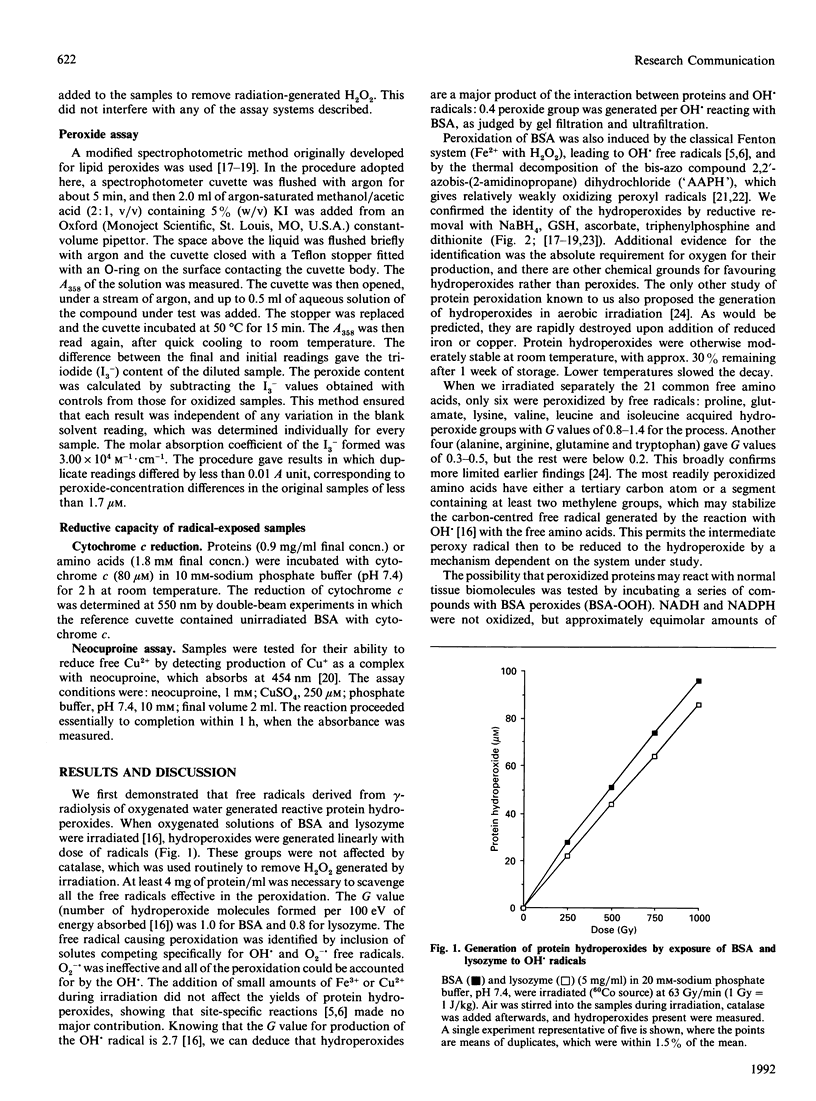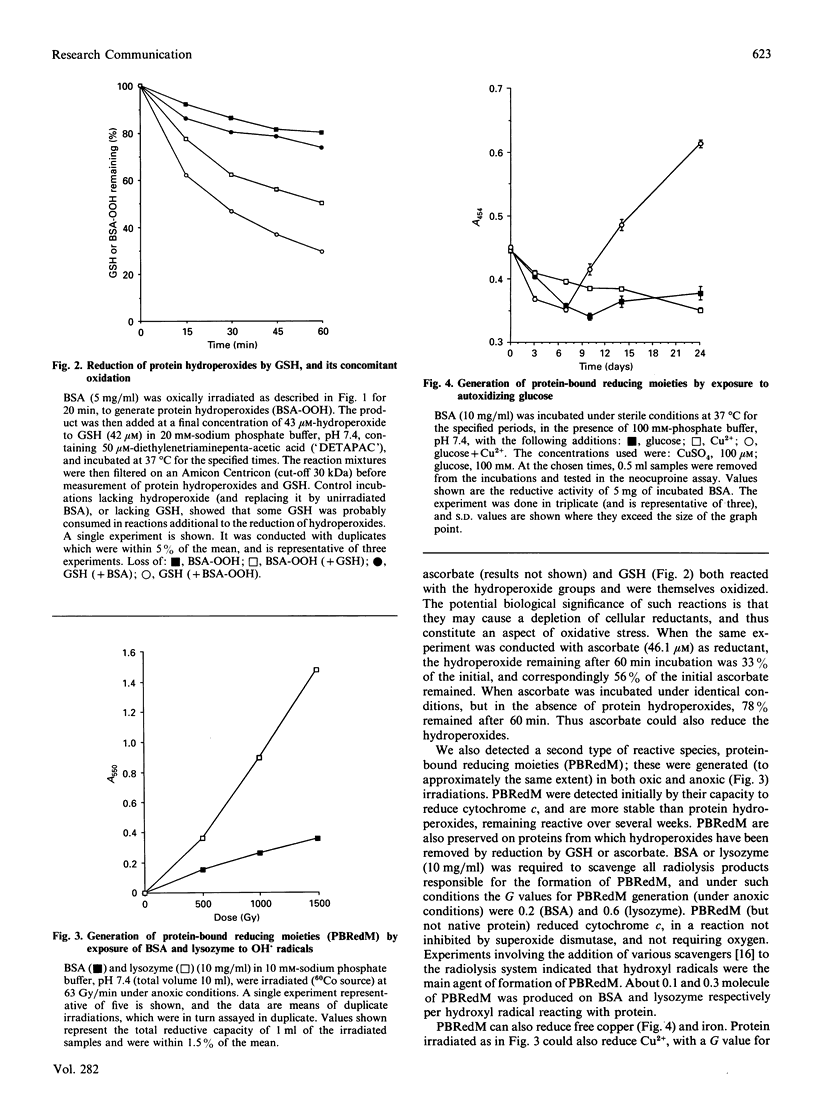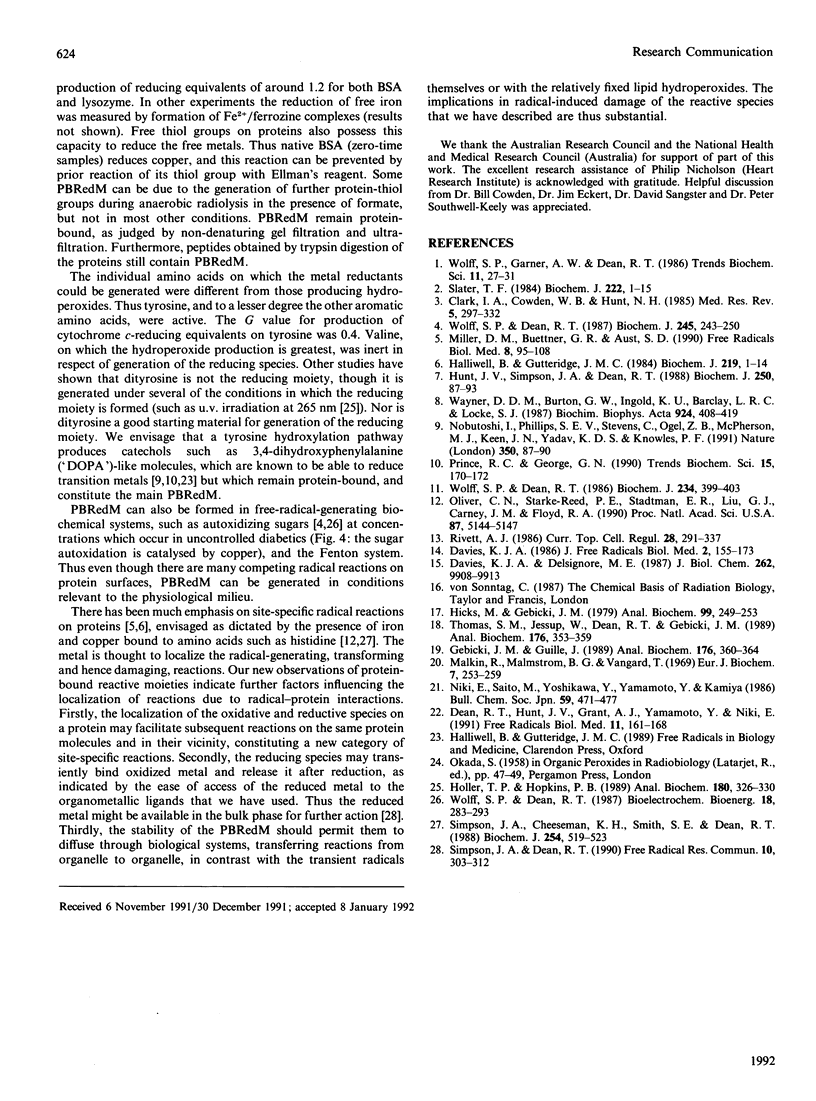Abstract
We have demonstrated two novel reactive species on radical-modified proteins which are relatively long-lived, one oxidizing and one reducing. The two species are reactive with critical biological components, and so may be of physiological and pathological importance. The oxidizing species, which have been identified as protein hydroperoxides, can consume key cellular reductants, such as ascorbate and glutathione. The reducing species can act on both free and metalloprotein forms of copper and iron ions, which participate in radical generation. These findings suggest that proteins may act as traps for the chemical energy released by free radicals, with the capacity to pass it on to other molecules. The long-lived nature of both the reactive moieties indicates that they may be able to diffuse and transfer damaging reactions to distant sites.
Full text
PDF



Selected References
These references are in PubMed. This may not be the complete list of references from this article.
- Clark I. A., Cowden W. B., Hunt N. H. Free radical-induced pathology. Med Res Rev. 1985 Jul-Sep;5(3):297–332. doi: 10.1002/med.2610050303. [DOI] [PubMed] [Google Scholar]
- Davies K. J., Delsignore M. E. Protein damage and degradation by oxygen radicals. III. Modification of secondary and tertiary structure. J Biol Chem. 1987 Jul 15;262(20):9908–9913. [PubMed] [Google Scholar]
- Dean R. T., Hunt J. V., Grant A. J., Yamamoto Y., Niki E. Free radical damage to proteins: the influence of the relative localization of radical generation, antioxidants, and target proteins. Free Radic Biol Med. 1991;11(2):161–168. doi: 10.1016/0891-5849(91)90167-2. [DOI] [PubMed] [Google Scholar]
- Gebicki J. M., Guille J. Spectrophotometric and high-performance chromatographic assays of hydroperoxides by the iodometric technique. Anal Biochem. 1989 Feb 1;176(2):360–364. doi: 10.1016/0003-2697(89)90323-0. [DOI] [PubMed] [Google Scholar]
- Halliwell B., Gutteridge J. M. Oxygen toxicity, oxygen radicals, transition metals and disease. Biochem J. 1984 Apr 1;219(1):1–14. doi: 10.1042/bj2190001. [DOI] [PMC free article] [PubMed] [Google Scholar]
- Hicks M., Gebicki J. M. A spectrophotometric method for the determination of lipid hydroperoxides. Anal Biochem. 1979 Nov 1;99(2):249–253. doi: 10.1016/s0003-2697(79)80003-2. [DOI] [PubMed] [Google Scholar]
- Holler T. P., Hopkins P. B. A qualitative fluorescence-based assay for tyrosyl radical scavenging activity: ovothiol A is an efficient scavenger. Anal Biochem. 1989 Aug 1;180(2):326–330. doi: 10.1016/0003-2697(89)90440-5. [DOI] [PubMed] [Google Scholar]
- Hunt J. V., Simpson J. A., Dean R. T. Hydroperoxide-mediated fragmentation of proteins. Biochem J. 1988 Feb 15;250(1):87–93. doi: 10.1042/bj2500087. [DOI] [PMC free article] [PubMed] [Google Scholar]
- Ito N., Phillips S. E., Stevens C., Ogel Z. B., McPherson M. J., Keen J. N., Yadav K. D., Knowles P. F. Novel thioether bond revealed by a 1.7 A crystal structure of galactose oxidase. Nature. 1991 Mar 7;350(6313):87–90. doi: 10.1038/350087a0. [DOI] [PubMed] [Google Scholar]
- Malkin R., Malmström B. G., Vänngård T. The reversible removal of one specific copper(II) from fungal laccase. Eur J Biochem. 1969 Jan;7(2):253–259. doi: 10.1111/j.1432-1033.1969.tb19600.x. [DOI] [PubMed] [Google Scholar]
- Miller D. M., Buettner G. R., Aust S. D. Transition metals as catalysts of "autoxidation" reactions. Free Radic Biol Med. 1990;8(1):95–108. doi: 10.1016/0891-5849(90)90148-c. [DOI] [PubMed] [Google Scholar]
- Oliver C. N., Starke-Reed P. E., Stadtman E. R., Liu G. J., Carney J. M., Floyd R. A. Oxidative damage to brain proteins, loss of glutamine synthetase activity, and production of free radicals during ischemia/reperfusion-induced injury to gerbil brain. Proc Natl Acad Sci U S A. 1990 Jul;87(13):5144–5147. doi: 10.1073/pnas.87.13.5144. [DOI] [PMC free article] [PubMed] [Google Scholar]
- Prince R. C., George G. N. Tryptophan radicals. Trends Biochem Sci. 1990 May;15(5):170–172. doi: 10.1016/0968-0004(90)90152-2. [DOI] [PubMed] [Google Scholar]
- Rivett A. J. Regulation of intracellular protein turnover: covalent modification as a mechanism of marking proteins for degradation. Curr Top Cell Regul. 1986;28:291–337. doi: 10.1016/b978-0-12-152828-7.50010-x. [DOI] [PubMed] [Google Scholar]
- Simpson J. A., Cheeseman K. H., Smith S. E., Dean R. T. Free-radical generation by copper ions and hydrogen peroxide. Stimulation by Hepes buffer. Biochem J. 1988 Sep 1;254(2):519–523. doi: 10.1042/bj2540519. [DOI] [PMC free article] [PubMed] [Google Scholar]
- Simpson J. A., Dean R. T. Stimulatory and inhibitory actions of proteins and amino acids on copper-catalysed free radical generation in the bulk phase. Free Radic Res Commun. 1990;10(4-5):303–312. doi: 10.3109/10715769009149899. [DOI] [PubMed] [Google Scholar]
- Slater T. F. Free-radical mechanisms in tissue injury. Biochem J. 1984 Aug 15;222(1):1–15. doi: 10.1042/bj2220001. [DOI] [PMC free article] [PubMed] [Google Scholar]
- Thomas S. M., Jessup W., Gebicki J. M., Dean R. T. A continuous-flow automated assay for iodometric estimation of hydroperoxides. Anal Biochem. 1989 Feb 1;176(2):353–359. doi: 10.1016/0003-2697(89)90322-9. [DOI] [PubMed] [Google Scholar]
- Wayner D. D., Burton G. W., Ingold K. U., Barclay L. R., Locke S. J. The relative contributions of vitamin E, urate, ascorbate and proteins to the total peroxyl radical-trapping antioxidant activity of human blood plasma. Biochim Biophys Acta. 1987 Jun 22;924(3):408–419. doi: 10.1016/0304-4165(87)90155-3. [DOI] [PubMed] [Google Scholar]
- Wolff S. P., Dean R. T. Fragmentation of proteins by free radicals and its effect on their susceptibility to enzymic hydrolysis. Biochem J. 1986 Mar 1;234(2):399–403. doi: 10.1042/bj2340399. [DOI] [PMC free article] [PubMed] [Google Scholar]
- Wolff S. P., Dean R. T. Glucose autoxidation and protein modification. The potential role of 'autoxidative glycosylation' in diabetes. Biochem J. 1987 Jul 1;245(1):243–250. doi: 10.1042/bj2450243. [DOI] [PMC free article] [PubMed] [Google Scholar]


